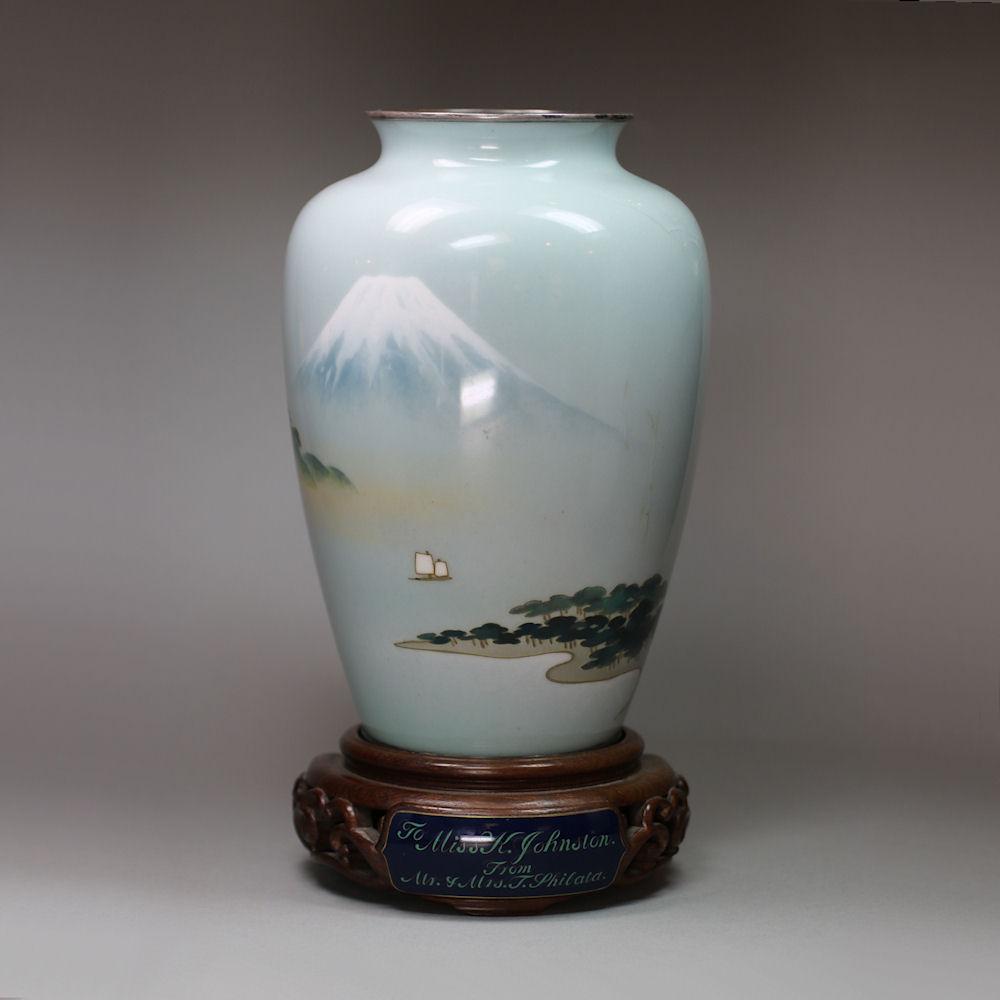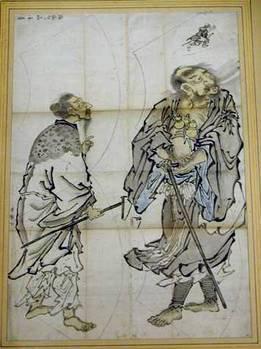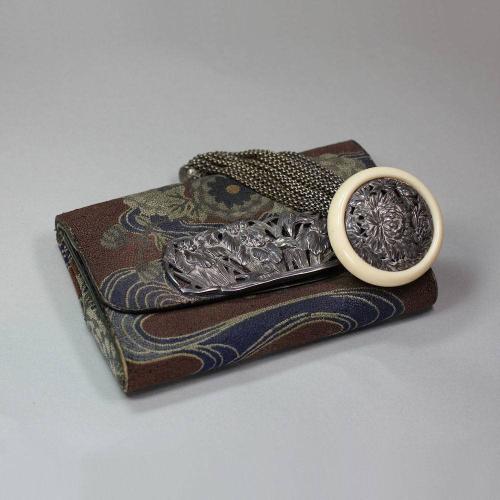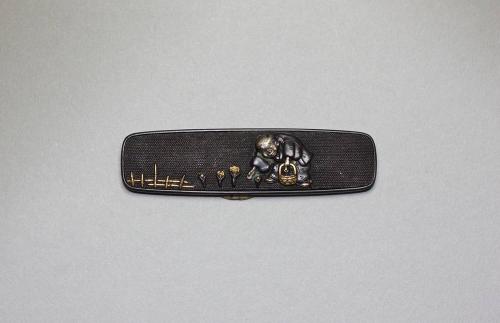

Price on application
This object is eligible for a Certificate of BADA Provenance
The BADA Standard
- Since 1918, BADA has been the leading association for the antiques and fine art trade
- Members are elected for their knowledge, integrity and quality of stock
- Our clients are protected by BADA’s code of conduct
- Our dealers’ membership is reviewed and renewed annually
- Bada.org is a non-profit site: clients deal directly with members and they pay no hidden fees
Japanese cloisonné vase with white metal mounts, circa 1900, the copper body with an applied white metal rim and base plate decorated in a soft pastel palette of predominantly blue enamels with a single boat upon a lake dotted with small tree-covered islets, with a snow-topped Mount Fuji rising in the background, the base with the mark of Ando, together with its original carved and scroll-pierced hardwood stand with a front plaque in blue and turquoise enamel reading ‘ To Miss K. Johnston. From Mr. & Mrs. T. Shibata', presented in the original silk-lined box, on the base of which is applied the original label ‘J Ando cloisonné Ware, Nagoya-Tokyo’.
Height: 18.3cm. (7 3/16in.)
Condition: Cracks (please refer to images).
Notes:
Cloisonné enamels (from the French ‘cloison’, meaning partition or decorative area) are known in Japan as shippo (七宝), a term also used to refer to the Seven Treasures of Buddhism. Though the list varies from text to text, these treasures are generally thought to include gold, silver, pearl, agate, crystal, coral and lapis lazuli. The jewel-like colours of early cloisonné enamels imported from Ming China fascinated Japanese craftsmen and by the 19th century Nagoya, Kyoto and Tokyo had become centres of innovation and the production of exceedingly high quality Japanese cloisonné wares. One highly celebrated company was the Ando manufactory, founded in Nagoya in 1880 by Shigezaemon Ando. Like other early cloisonné producers, Ando made wares specifically targeted to appeal to the new wave of European and American tourists flocking to experience for themselves the mysterious delights of Japan after the country opened its borders to foreigners at the start of the Meiji period. With this new trend for touring Japan came a burgeoning interest amongst travellers in Japanese craft and art items, including ceramics, lacquerware and cloisonné, with many wealthy patrons enjoying tours of workshops and consequent spending sprees in the dedicated showrooms afterwards (it was only much later that cloisonné wares became popular domestically, among Japanese buyers). This popularity is reflected in the success of Japanese cloisonné wares at the great ‘World Fairs’, including the Vienna Exhibition of 1873 at which the Nagoya Cloisonné Company, later taken over by the Ando Company, won first prize, and the World’s Columbian Exhibition of 1893 in Chicago, at which the Ando Company also won a prize. Amidst this success the company expanded, opening a new branch in stylish Ginza, which was an affluent area of Tokyo popular amongst visiting foreigners, before relocating again to another Tokyo property in the 1890s. The company continued to experiment and develop new innovative techniques throughout this time, including the manufacture of transparent or semi-transparent enamels. In 1900, around the time this vase was made, the company was appointed purveyor to the Imperial Household, the highest possible recognition of excellence amongst craftsmen and artists. In his 1911 article on cloisonné enamels, Harada Jiro discusses the top factories operating at that time, stating that ‘perhaps the best-known Japanese shippō manufacturer is Ando Jubei of that city [Nagoya]. […] Ando’s rare insight in noting what is best suited for the time and his valuable judgement of colour and form, together with the talent to get the best out of each of the large number of expert enamel artists that came to work for him, enabled him to send out unusually good specimens of shippō ware. He has one large factory, but he also has many artists in different parts of Nagoya and Toshima working exclusively for him’ Harada Jiro (1911) ‘Japanese Art and Artists of To-Day, VI. Cloisonne Enamel-Work,’ The Studio, vol. 53 no.219 (pp.271-286).
Dimensions
Height: 18.3cm. (7 3/16in.)Condition report
CracksStock number
P757The BADA Standard
- Since 1918, BADA has been the leading association for the antiques and fine art trade
- Members are elected for their knowledge, integrity and quality of stock
- Our clients are protected by BADA’s code of conduct
- Our dealers’ membership is reviewed and renewed annually
- Bada.org is a non-profit site: clients deal directly with members and they pay no hidden fees




